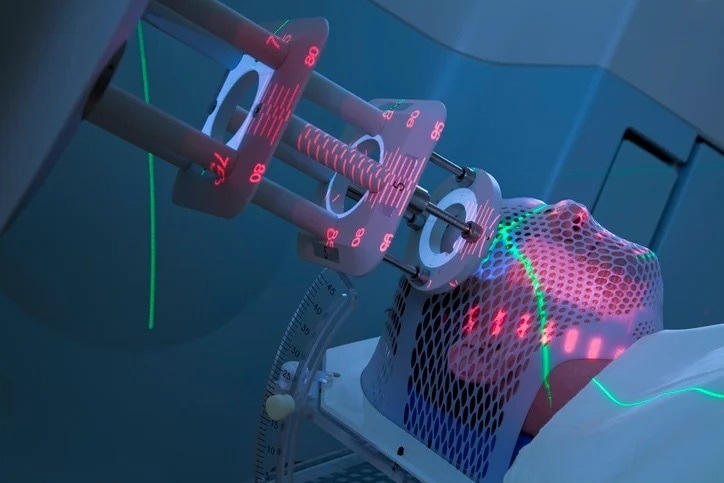At the little-explored intersection of organic and inorganic chemistry, a new material made could not only allow highly powerful solar panels but could also guide the next generation of cancer treatments.

Man receiving radiotherapy treatment for cancer. Image Credit: Mark Kostich/iStock/Getty
Having been explained in a Nature Chemistry journal that has been recently reported, the composite is composed of ultra-tiny silicon nanoparticles and an organic element directly linked to those utilized in OLED televisions. It has the potential to increase the speed with which two molecules have the potential to exchange energy and transform lower-energy light into higher-energy light.
Just a handful of laboratories in the world have the potential to make silicon nanoparticles with the correct specifications. One of those laboratories has been guided by Lorenzo Mangolini, a mechanical engineering and materials science professor at the University of California-Riverside, who assisted in inventing the process for producing them.
The new material improves on previous attempts we’ve made to create something that efficiently exchanges energy between two dissimilar components. There are great opportunities to use this for a wide variety of applications, but perhaps one of the most important, from a human health perspective, is for cancer.
Lorenzo Mangolini, Mechanical Engineering and Materials Science Professor, University of California-Riverside
High-energy light, like ultraviolet laser light, can potentially develop free radicals that can attack cancer tissue. But UV light does not travel so far into tissues to produce therapeutic radicals next to the tumor site. On the contrary, near-infrared light gets penetrated deeply into the body but does not have sufficient energy to produce the radicals.
With the availability of the new material, the research group has illustrated it is possible to obtain the emission of light having greater energy compared to the one aimed at the material, called photon up-conversion. Besides being efficient, the silicon “dots” that develop the base of this high-energy material are not poisonous.
Taking low-energy light and converting it into a greater energy form can increase solar cells' efficiency. This enables them to capture near-infrared light that would generally pass through them. While being subjected optimized, the low-energy light could reduce the size of solar panels by 30%.
These cells usually don’t use low-energy photons, but using this system, you could. We could make the arrays much more efficient.
Lorenzo Mangolini, Mechanical Engineering and Materials Science Professor, University of California-Riverside
With the new silicon dot-based material, there is the availability of a range of applications involving infrared light that can be enhanced. They include light-based 3D printing, bioimaging, and light sensors that would assist self-driving cars through foggy weather.
This study was financially supported by the National Science Foundation and was executed by a research group based at the University of Texas, Austin, the University of Colorado, Boulder, and the University of Utah, as well as UCR. Not only the research group is excited about the possible applications but also about being capable of designing a new class of composite materials similar to this one.
Composites are known as materials that act differently compared to their base components when acting alone. For instance, composites of resins and carbon fibers are lightweight and strong and are utilized in airplane wings and several sporting goods.
We now know how to take two extremely different substances and bond them strongly enough to create not just a mixture, but an entirely new material with distinct properties. This is one of the first times this has been achieved.
Sean Roberts, Study Corresponding Author and Chemistry Professor, University of Texas at Austin
Journal Reference
Wang, K., et al. (2023) Efficient photon upconversion enabled by strong coupling between silicon quantum dots and anthracene. Nature Chemistry. doi.org/10.1038/s41557-023-01225-x.